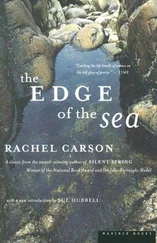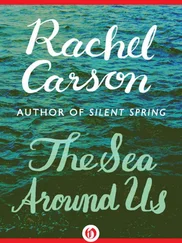For the most part this pollution is unseen and invisible, making its presence known when hundreds or thousands of fish die, but more often never detected at all. The chemist who guards water purity has no routine tests for these organic pollutants and no way to remove them. But whether detected or not, the pesticides are there, and as might be expected with any materials applied to land surfaces on so vast a scale, they have now found their way into many and perhaps all of the major river systems of the country.
If anyone doubts that our waters have become almost universally contaminated with insecticides he should study a small report issued by the United States Fish and Wildlife Service in 1960. The Service had carried out studies to discover whether fish, like warm-blooded animals, store insecticides in their tissues. The first samples were taken from forest areas in the West where there had been mass spraying of DDT for the control of the spruce budworm. As might have been expected, all of these fish contained DDT. The really significant findings were made when the investigators turned for comparison to a creek in a remote area about 30 miles from the nearest spraying for budworm control. This creek was upstream from the first and separated from it by a high waterfall. No local spraying was known to have occurred. Yet these fish, too, contained DDT. Had the chemical reached this remote creek by hidden underground streams? Or had it been airborne, drifting down as fallout on the surface of the creek? In still another comparative study, DDT was found in the tissues of fish from a hatchery where the water supply originated in a deep well. Again there was no record of local spraying. The only possible means of contamination seemed to be by means of groundwater.
In the entire water-pollution problem, there is probably nothing more disturbing than the threat of widespread contamination of groundwater. It is not possible to add pesticides to water anywhere without threatening the purity of water everywhere. Seldom if ever does Nature operate in closed and separate compartments, and she has not done so in distributing the earth’s water supply. Rain, falling on the land, settles down through pores and cracks in soil and rock, penetrating deeper and deeper until eventually it reaches a zone where all the pores of the rock are filled with water, a dark, subsurface sea, rising under hills, sinking beneath valleys. This groundwater is always on the move, sometimes at a pace so slow that it travels no more than 50 feet a year, sometimes rapidly, by comparison, so that it moves nearly a tenth of a mile in a day. It travels by unseen waterways until here and there it comes to the surface as a spring, or perhaps it is tapped to feed a well. But mostly it contributes to streams and so to rivers. Except for what enters streams directly as rain or surface runoff, all the running water of the earth’s surface was at one time groundwater. And so, in a very real and frightening sense, pollution of the groundwater is pollution of water everywhere.
It must have been by such a dark, underground sea that poisonous chemicals traveled from a manufacturing plant in Colorado to a farming district several miles away, there to poison wells, sicken humans and livestock, and damage crops—an extraordinary episode that may easily be only the first of many like it. Its history, in brief, is this. In 1943, the Rocky Mountain Arsenal of the Army Chemical Corps, located near Denver, began to manufacture war materials. Eight years later the facilities of the arsenal were leased to a private oil company for the production of insecticides. Even before the change of operations, however, mysterious reports had begun to come in. Farmers several miles from the plant began to report unexplained sickness among livestock; they complained of extensive crop damage. Foliage turned yellow, plants failed to mature, and many crops were killed outright. There were reports of human illness, thought by some to be related.
The irrigation waters on these farms were derived from shallow wells. When the well waters were examined (in a study in 1959, in which several stare and federal agencies participated) they were found to contain an assortment of chemicals. Chlorides, chlorates, salts of phosphonic acid, fluorides, and arsenic had been discharged from the Rocky Mountain Arsenal into holding ponds during the years of its operation. Apparently the groundwater between the arsenal and the farms had become contaminated and it had taken 7 to 8 years for the wastes to travel underground a distance of about 3 miles from the holding ponds to the nearest farm. This seepage had continued to spread and had further contaminated an area of unknown extent. The investigators knew of no way to contain the contamination or halt its advance.
All this was bad enough, but the most mysterious and probably in the long run the most significant feature of the whole episode was the discovery of the weed killer 2,4-D in some of the wells and in the holding ponds of the arsenal. Certainly its presence was enough to account for the damage to crops irrigated with this water. But the mystery lay in the fact that no 2,4-D had been manufactured at the arsenal at any stage of its operations.
After long and careful study, the chemists at the plant concluded that the 2,4-D had been formed spontaneously in the open basins. It had been formed there from other substances discharged from the arsenal; in the presence of air, water, and sunlight, and quite without the intervention of human chemists, the holding ponds had become chemical laboratories for the production of a new chemical—a chemical fatally damaging to much of the plant life it touched.
And so the story of the Colorado farms and their damaged crops assumes a significance that transcends its local importance. What other parallels may there be, not only in Colorado but wherever chemical pollution finds its way into public waters? In lakes and streams everywhere, in the presence of catalyzing air and sunlight, what dangerous substances may be born of parent chemicals labeled “harmless"?
Indeed one of the most alarming aspects of the chemical pollution of water is the fact that here—in river or lake or reservoir, or for that matter in the glass of water served at your dinner table—are mingled chemicals that no responsible chemist would think of combining in his laboratory. The possible interactions between these freely mixed chemicals are deeply disturbing to officials of the United States Public Health Service, who have expressed the fear that the production of harmful substances from comparatively innocuous chemicals may be taking place on quite a wide scale. The reactions may be between two or more chemicals, or between chemicals and the radioactive wastes that are being discharged into our rivers in ever-increasing volume. Under the impact of ionizing radiation some rearrangement of atoms could easily occur, changing the nature of the chemicals in a way that is not only unpredictable but beyond control.
It is, of course, not only the groundwaters that are becoming contaminated, but surface-moving waters as well—streams, rivers, irrigation waters. A disturbing example of the latter seems to be building up on the national wildlife refuges at Tule Lake and Lower Klamath, both in California. These refuges are part of a chain including also the refuge on Upper Klamath Lake just over the border in Oregon. All are linked, perhaps fatefully, by a shared water supply, and all are affected by the fact that they lie like small islands in a great sea of surrounding farmlands—land reclaimed by drainage and stream diversion from an original waterfowl paradise of marshland and open water.
These farmlands around the refuges are now irrigated by water from Upper Klamath Lake. The irrigation waters, re-collected from the fields they have served, are then pumped into Tule Lake and from there to Lower Klamath. All of the waters of the wildlife refuges established on these two bodies of water therefore represent the drainage of agricultural lands. It is important to remember this in connection with recent happenings.
Читать дальше












